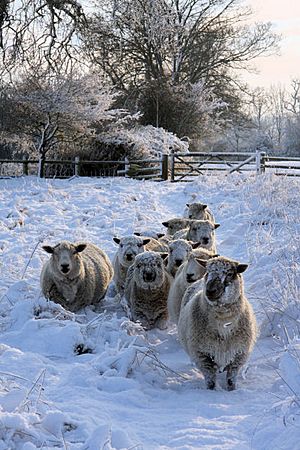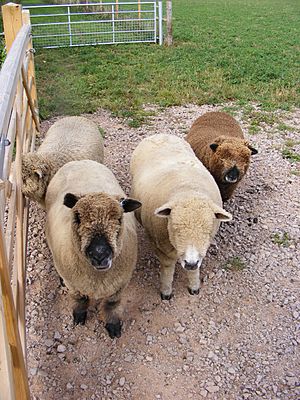Ryeland facts for kids
The Ryeland is a very old sheep breed from England. Monks in Leominster, Herefordshire, started breeding them about 700 years ago. They grazed these sheep on fields of rye, which is how the breed got its name.
Ryeland sheep were brought to Australia in 1919. In Australia, they are now considered an endangered breed by the Rare Breeds Trust of Australia. They were also one of the nine main breeds that helped start Australia's sheep and wool industry. Ryeland sheep helped create the Poll Dorset breed by passing on a special gene that means the sheep are born without horns. These sheep are mostly raised for their meat.
Contents
What Makes Ryeland Sheep Special?
Ryeland sheep are known for being calm and easy to handle. They also have many lambs, which means they are very fertile. Because of their strong, blocky build, they are less likely to push down fences than other sheep breeds. This makes them a great choice for smaller farms or properties.
These sheep are also known as "good-doers." This means they can stay healthy even when there isn't a lot of food. An old saying about them is that they "endure privation of food better than any other breed."
Physical Traits
Ryeland sheep have smaller heads compared to many other meat breeds. This makes them a good choice for breeding with younger or Merino ewes. They also grow quickly and mature early. In Australia, their wool is always white and free of kemp, which are coarse, hairy fibers.
Sometimes, a colored gene appears in Ryeland sheep in Great Britain, but it seems to be rare in Australia. Their hooves are black, and they are thought to be good at resisting footrot, a common sheep disease. Ryeland sheep are naturally born without horns. This hornless trait was very important in developing the Poll Dorset breed in Australia.
Ryeland Wool
The wool from Ryeland sheep resists felting, which means it doesn't easily mat together. The wool fibers are usually 8 to 10 centimeters long. The thickness of the fiber is about 25 to 28 microns. On average, a fleece from one Ryeland sheep weighs between 2 and 3 kilograms.
Queen Elizabeth I's Favorite Wool
Ryeland wool was once thought to be the finest wool from any British sheep breed. Queen Elizabeth I loved stockings made from "Lemster" wool. "Lemster" wool came from Ryeland sheep in the Leominster area. She liked them so much that she insisted on only wearing stockings made from this special wool.
An observer from Queen Elizabeth's time wrote that "among short-wools, Ryeland has pre-eminence." This means Ryeland wool was considered the best among shorter-fibered wools. Leominster was the main center for trading this wool.
Ryeland Sheep in Art
The Ryeland sheep is featured in a famous book by David Low. The book is called The Breeds of the Domestic Animals of the British Islands and was published in 1841. It was a pioneering work that showed the ancestors of many important breeds of horses, cows, sheep, and pigs.
David Low was a professor of agriculture at the University of Edinburgh. He was worried that many farmers didn't understand how to choose the best breed for their environment. He also wanted them to learn how to improve their animals' productivity. With help from Earl Spencer, Low created an agricultural museum in Edinburgh. He hired William Shiels to paint beautiful pictures of all the important farm animal breeds in Great Britain at that time.




